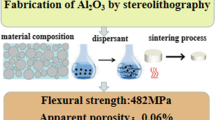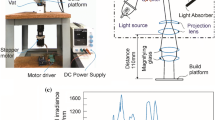Abstract
Stereolithography-based additive manufacturing (AM) makes it possible to realize high-quality ceramic parts with various shapes. However, preparation of ceramic slurry with high solid loading, low viscosity, long-term stability, and desirable cure depth for stereolithography is still challenging. In this paper, research is carried out for revealing the effects of dispersant, solid loading, and mixing method on the stability and viscosity of the slurry. Under optimized conditions, a highly stable yttria-stabilized zirconia ceramic slurry with high solid loading (45 vol.%) was prepared by grinding with a three-roller mill. With layer thickness of 30 μm and exposure dose of 10 mJ/cm2 (10 mW/cm2 for 1 s), ceramic green bodies with complex shape were successfully fabricated. After sintering, the final ceramic parts showed well-defined shapes with high level of densification.
Graphical Abstract

In this work, 3Y-TZP ceramic slurry was successfully prepared by the modified powders via dispersant and grinding and dispersing with a three-roller mill. Finally, ceramic parts with complex shape and excellent performance were achieved.










Similar content being viewed by others
References
Keiteb AS, Saion E, Zakaria A, Soltani N (2016) Structural and optical properties of zirconia nanoparticles by thermal treatment synthesis. J Nanomater 2016:1–6. https://doi.org/10.1155/2016/1913609
Nakai H, Inokoshi M, Nozaki K, Komatsu K, Kamijo S, Liu H, Shimizubata M, Minakuchi S, Van Meerbeek B, Vleugels J, Zhang F (2021) Additively manufactured mirconia for dental applications. Mater 14(13):3694–3703. https://doi.org/10.3390/ma14133694
Chen F, Zhu H, Wu JM, Chen S, Cheng LJ, Shi YS, Mo YC, Li CH, Xiao J (2020) Preparation and biological evaluation of ZrO2 all-ceramic teeth by DLP technology. Ceram Int 46(8):11268–11274. https://doi.org/10.1016/j.ceramint.2020.01.152
Jin XT, Yuan KK, Han WJ, Wang XQ, Li CS (2021) Enhanced surface area and thermal stability of mesoporous zirconia fibers modified by various oxides and the reinforcement mechanism. Ceram Int 47(23):32579–32587. https://doi.org/10.1016/j.ceramint.2021.08.153
Arisoy FD, Czolkos I, Johansson A, Nielsen T, Watkins JJ (2020) Low-cost, durable master molds for thermal-NIL, UV-NIL, and injection molding. Nanotechnology 31(1):015302. https://doi.org/10.1088/1361-6528/ab4507
He JQ, Shao ZJ, Khan DF, Yin H, Elder S, Zheng QJ, Qu XH (2018) Investigation of inhomogeneity in powder injection molding of nano zirconia Investigation of inhomogeneity in powder injection molding of nano zirconia. 328:207–214. https://doi.org/10.1016/j.powtec.2017.12.075
Liao JJ, Zhang D, Wu XW, Luo H, Zhou KC, Su B (2019) Preparation of high strength zirconia by epoxy gel-casting using hydantion epoxy resin as a gelling agent Mater. Sci Eng C 96:280–285. https://doi.org/10.1016/j.msec.2018.11.023
Galante R, Figueiredo-Pina C, Serro AP (2019) Additive manufacturing of ceramics for dental applications: a review. Dent Mater 35(6):825–846. https://doi.org/10.1016/j.dental.2019.02.026
Travitzky N, Bonet A, Dermeik B, Fey T, Filbert-Demut I, Schlier L, Schlordt T, Greil P (2014) Additive manufacturing of ceramic-based materials. Adv Eng Mater 16(6):729–754. https://doi.org/10.1002/adem.201400097
Huang J, Qin Q, Wang J (2020) A review of stereolithography: processes and systems. Processes 8(9):1138. https://doi.org/10.3390/pr8091138
Zhang C, Jiang ZL, Zhao L, Guo WW, Gao XQ (2021) Stability, rheological behaviors, and curing properties of 3Y–ZrO2 and 3Y–ZrO2/GO ceramic suspensions in stereolithography applied for dental implants. Ceram Int 47(10):13344–13350. https://doi.org/10.1016/j.ceramint.2021.01.191
Sun JX, Binner J, Bai JM (2019) Effect of surface treatment on the dispersion of nano zirconia particles in non-aqueous suspensions for stereolithography. J Eur Ceram Soc 39(4):1660–1667. https://doi.org/10.1016/j.jeurceramsoc.2018.10.024
Camargo ILD, Erbereli R, Taylor H, Fortulan CA (2021) 3Y-TZP DLP additive manufacturing: solvent-free slurry development and characterization. Mater Res 24(2):1–8. https://doi.org/10.1590/1980-5373-mr-2020-0457
Singhal A, Skandan G, Wang A, Glumac N, Kear BH, Hunt RD (1999) On nanoparticle aggregation during vapor phase synthesis. NanoStruct Mater 11(4):545–552. https://doi.org/10.1016/S0965-9773(99)00343-8
Zhang KQ, Meng QY, Zhang XQ, Qu ZL, Jing SK, He RJ (2021) Roles of solid loading in stereolithography additive manufacturing of ZrO2 ceramic. Int J Refract Met Hard Mater 99(2021):105604. https://doi.org/10.1016/j.ijrmhm.2021.105604
Zhang KQ, Xie C, Wang G, He RJ, Ding GJ, Wang M, Dai DW, Fang DN (2019) High solid loading, low viscosity photosensitive Al2O3 slurry for stereolithography based additive manufacturing. Ceram Int 45(1):203–208. https://doi.org/10.1016/j.ceramint.2018.09.152
Ding GJ, He RJ, Zhang KQ, Xia M, Feng CW, Fang DN (2020) Dispersion and stability of SiC ceramic slurry for stereolithography. Ceram Int 46(4):4720–4729. https://doi.org/10.1016/j.ceramint.2019.10.203
Zhang KQ, He RJ, Xie C, Wang G, Ding GJ, Wang M, Song WD, Fang DN (2019) Photosensitive ZrO2 suspensions for stereolithography. Ceram Int 45(9):12189–12195. https://doi.org/10.1016/j.ceramint.2019.03.123
Acosta M, Wiesner VL, Martinez CJ, Trice RW, Youngblood JP (2013) Effect of polyvinylpyrrolidone additions on the rheology of aqueous, highly loaded alumina suspensions. J Am Ceram Soc 96(5):1372–1382. https://doi.org/10.1111/jace.12277
Dufaud O, Marchal P, Corbel S (2002) Rheological properties of PZT suspensions for stereolithography. J Eur Ceram Soc 22(13):2081–2092. https://doi.org/10.1016/s0955-2219(02)00036-5
Jang JH, Wang SH, Pilgrim SM, Schulze WA (2004) Preparation and characterization of barium titanate suspensions for stereolithography. J Am Ceram Soc 83(7):1804–1806. https://doi.org/10.1111/j.1151-2916.2000.tb01467.x
Hermansson M (1999) The DLVO theory in microbial adhesion. Colloids Surf, B 14(1):105–119. https://doi.org/10.1016/s0927-7765(99)00029-6
Lin HW, Hwu WH, Cer MD (2008) The dispersion of silver nanoparticles with physical dispersal procedures. J Mater Process Technol 206:56–61. https://doi.org/10.1016/j.jmatprotec.2007.12.025
Sun JX, Binner J, Bai JM (2020) 3D printing of zirconia via digital light processing: optimization of slurry and debinding process. J Eur Ceram Soc 40(15):5837–5844. https://doi.org/10.1016/j.jeurceramsoc.2020.05.079
Acknowledgements
This work was supported by the National Key R&D Program of China (Grant No. 2022YFE0197100), Shenzhen Science and Technology Innovation Commission (Grant No. JCYJ20190809111603608 and JCYJ20190809103803675), Post-doctoral Foundation Project of Shenzhen Polytechnic (Grant No. 6021330019K0 and 6021330011K0), Innovation Project of Shenzhen Polytechnic (Grant No. CXGC2021C0003), Natural Science Foundation of Guangdong Province, China (Grant No. 2020A1515011194 and 2019B1515120013), Guangdong Provincial General University Innovation Team Project (Grant No. 2020KCXTD047) and Graduate Innovative Research Fund of Wuhan Institute of Technology (Grant No. CX2021169).
Author contributions
All authors contributed to the study’s conception and design. Material preparation and data collection were performed by YiJ, GY, JS, and WY. FG, JB, MY, and GL participated in the data analysis and logical analysis of the article. The first draft of the manuscript was written by YJ, and all authors commented an previous versions of the manuscript. All authors read and approved the final manuscript.
Author information
Authors and Affiliations
Corresponding authors
Ethics declarations
Conflict of interest
The authors declare no competing interests.
Additional information
Publisher’s note Springer Nature remains neutral with regard to jurisdictional claims in published maps and institutional affiliations.
Rights and permissions
Springer Nature or its licensor (e.g. a society or other partner) holds exclusive rights to this article under a publishing agreement with the author(s) or other rightsholder(s); author self-archiving of the accepted manuscript version of this article is solely governed by the terms of such publishing agreement and applicable law.
About this article
Cite this article
Jiao, Y., Ye, G., Sun, J. et al. A comprehensive study on zirconia slurry for stereolithography-based additive manufacturing. J Sol-Gel Sci Technol 105, 827–835 (2023). https://doi.org/10.1007/s10971-022-06021-6
Received:
Accepted:
Published:
Issue Date:
DOI: https://doi.org/10.1007/s10971-022-06021-6




